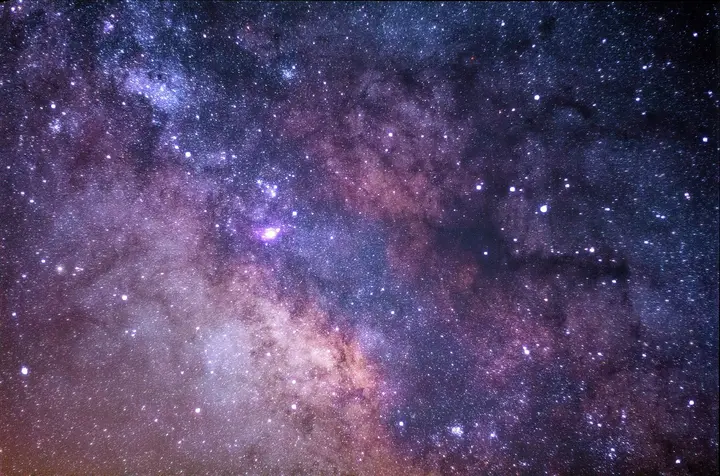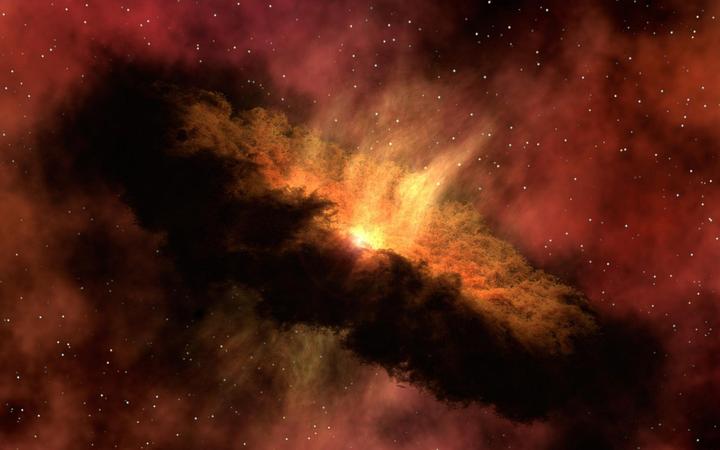Illuminating the Cosmos: The Spectacular Light Shows of Stellar Explosions

Deep in the vast and mysterious universe, a symphony of fascinating and surprising lighting takes place. It's the lighting of stellar eruptions, those picturesque natural phenomena that occur when the life of stars ends with huge explosions. These explosions are considered one of the most exciting events in the universe, displaying enchanting paintings of light, color and energy.
Show key points
- Stellar explosions mark the dramatic end of a star's life, releasing immense energy and forming spectacular cosmic light displays.
- These explosions produce gamma rays—the most powerful radiation in the universe—that travel across vast distances, offering insight into cosmic origins.
- The collapse of a star's core due to depleted nuclear fuel leads to the formation of dense neutron stars and the emission of various radiation types.
- ADVERTISEMENT
- Studying stellar bangs reveals critical information about the formation of elements, star evolution, galaxy creation, and the structure of the universe.
- Starbursts influence life on Earth through cosmic radiation, atmospheric changes, and the delivery of heavy elements via meteorites.
- The energy and matter emitted during stellar explosions significantly alter gravitational fields and thermal dynamics in the surrounding cosmic environment.
- Enhanced understanding of stellar explosions is driving innovation in astronomical technology and contributing to the search for extraterrestrial life.
Understanding stellar bangs: what are they and how do they occur?

Starbursts are one of the most striking and surprising cosmic phenomena. It is the result of the end of the life of the stars, producing enormous energy manifested in huge explosions that light up the sky and create mesmerizing paintings. Despite their supernatural beauty, understanding these bangs requires careful study and deep analysis.
Recommend
Stellar explosions occur when the nuclear fuel in the star's core runs out and its thermal pressure drops dramatically. This causes the star to collapse on itself by the intense force of gravity. During this phase, a dense nucleus made up of neutrons and protons is formed, generally called a neutron star. At the moment of the stellar explosion, the neutron nucleus is subjected to a huge compressive force equivalent to millions of tons, causing it to rush at tremendous speed into space, simultaneously emitting light waves, gamma rays, X-rays and other radiation.
Understanding the factors that cause stellar explosions needs to be thoroughly studied to understand the gravitational forces, nuclear reactions, and thermal changes within stars. Many factors contribute to these explosions, such as the star's mass, chemical composition, age, and size. By understanding these factors, we can contribute to predicting and studying stellar explosions more efficiently.
Star bangs are exciting and unusual astronomical events. They form monumental paintings of light, energy and color, celebrating the end of the stars' lives and opening the door to birth and upbringing. Understanding this amazing phenomenon enhances our understanding of the universe and its evolution, and contributes to the progress of astronomy and its future discoveries. Let us explore and enjoy this fascinating world and learn its deep secrets from it.
Gamma rays: bright lights of stellar bursts

Your eyes catch a glimpse of bright light twinkling in the shining sky. This mysterious light radiating from the deep depth of the universe is the product of massive stellar explosions known as gamma rays. It's the longest cosmic ray to reach Earth, but it carries with it an enormous mystery that raises questions about these mysterious displays of light.
When a star's life ends with a massive explosion, a huge amount of energy associated with that explosion is released. This enormous energy is transformed into gamma rays, which radiate the deadliest and most intense radiation in the known universe. These rays range in a variety of effectiveness, and their impact spans thousands and possibly millions of light-years in space.
Gamma rays are extremely high-energy, consisting of particles of very high energy that cross space at the speed of light. For astronomers, these rays embody a very different world with enormous events that we follow and study with passion.
These bright rays carry with them a lot of mysteries and challenges for scientists. They are not easy to detect or control, and sometimes this requires the use of powerful devices such as space telescopes and satellite networks to monitor them, determine their source and understand their nature.
Exploring gamma rays is an exciting scientific challenge that contributes to our understanding of the process of origin and disintegration of stars and their impact on the surrounding universe. The ability to observe and analyze these bright rays contributes to building our view of the universe and sheds light on its evolution and formation.
By exploring gamma rays, we are exposed to immense energy and spectacular light displays that highlight the beauty of the universe we live in. It's a powerful reminder that there's more to it than we see on the dark night, and that there are fascinating stories unfolding in stellar burst shows. Let's stay excited to discover more secrets of the universe and radiant gamma rays in the dark sky.
What stellar explosions can reveal to us about the formation of the universe

Star explosions possess an exceptional ability to unravel the secrets of the formation of the universe and its complex interactions. When stars explode, they release huge amounts of energy and matter into the surrounding space, giving us a unique opportunity to study the impact of these explosions on the universe and its formation processes. Here's a look at what stellar bangs can reveal about the formation of the universe:
1. Formation of elements: Star explosions are one of the main factors in the formation of chemical elements in the universe. When stars explode, they launch many different elements into space, helping to form heavy elements such as iron, gold, and silver.
2. Star evolution: By studying stellar explosions, we can understand how stars evolve from the moment they form until the end of their lives. Star explosions provide valuable information about the physical and chemical processes that occur inside stars and affect their formation and evolution.
3. Age of the universe: By studying stellar explosions and researching their impact on the universe, we can estimate the age of the universe and understand how it evolved over the ages. Star explosions act as a powerful time marker that helps us identify certain periods in the history of the universe.
4. Cosmic structures: Star explosions also influence the formation of larger cosmic structures, such as new stars and galaxies. When stars explode, gas and matter can form in new stars and contribute to the formation of galaxies.
5. Dark energy and dark matter: It is thought that stellar explosions may contribute to the understanding of mysterious objects in the universe, such as dark energy and dark matter. These explosions may reveal unknown effects of energy and matter, helping us explain the nature of these mysterious phenomena.
6. Life in the universe: Star explosions represent a unique window into the study of the possibility of life in the universe. When stars explode, it gives us a deep study of the environmental factors and conditions that support life, enabling us to identify planets and star systems that may be habitable.
There is no doubt that stellar explosions have the unique ability to uncover the secrets of the formation of the universe and its complex processes. By studying this picturesque phenomenon, we have the opportunity to explore and better understand the deep mystery of the universe.
The Impact of Star Explosions on Life on Earth

Star explosions are not just mere mesmerizing light displays in the universe, they have a profound impact on life on Earth. These explosions are powerful astronomical events that can affect the environment and living organisms of our planet. What is the impact of these stellar explosions on life on Earth? And how does its light and energy affect living organisms? Let's take a closer look at this terrible astronomical impact.
Cosmic radiation effect: Star explosions release huge amounts of energy, including cosmic radiation. This radiation can reach the ground and directly affect living organisms. Cosmic radiation can cause changes in DNA and affect the process of biological development of living organisms. This effect may lead to changes in genetics, reproduction and even in the overall health of certain species.
Impact on the atmosphere: Star explosions interact with the Earth's atmosphere, resulting in the formation of the ozone layer. Large amounts of cosmic radiation may destroy part of the ozone layer, causing more harmful ultraviolet radiation to enter the Earth's surface. This can affect plants, animals and even human health.
Heavy elements form: Star explosions are also a place for heavy elements such as iron, gold, and silver to form. When giant stars explode, these elements are released into the universe. Earth can be affected by these heavy elements when they fall to its surface by comets or meteorites, leading to changes in the planet's geological composition.
Magical lighting effect: Star explosions give us amazing and charming light shows, and this can affect our emotions and spirit. The gasp and amazement evoked by that enchanting lighting can influence our thinking and inspiration, and may lead to the development of science and the arts.
Star explosions have a significant impact on life on Earth. These explosions pose a challenge and opportunity for scientists to understand the depths of the universe and complex physical interactions. Despite the potential negative effects, stellar explosions also give us a chance to reflect, be inspired and realize that we are part of this vast and beautiful universe.
Physical effects of stellar explosions on the universe

Star explosions leave their unique mark on the universe, releasing a stunning flow of light, energy and charged matter. A tremendous physical impact arises when this explosive energy is dynamically discharged into empty space. A set of phenomena and changes occur that affect the order of the entire universe. Let's explore some of these enchanting physical influences and learn how they formed and affect the universe.
When a star explodes, its material-rich contents are violently released. Gaseous particles and charged matter form in an enormous cloud that stretches countless paths in outer space. Part of this material is directed by stellar wind and other activities resulting from the explosion itself. These molecules begin to interact with the gas and surrounding matter, forming various shapes such as the rotating sun and light sparks. These physical influences span spectacularly over great distances in the universe.
In addition to the physical response, effects on the speed of surrounding stars and planets also occur. A stellar explosion could cause a cosmic object to move out of its normal trajectory, due to the enormous momentum of volatile charged matter. This stirring can cause changes in the planetary system and repercussions on the surrounding gravitational fields. It is an amazing physical effect reminiscent of the power of the natural laws that govern the universe.
However, the impact of stellar explosions is not limited to fragility and changes, but also extends to the release of huge amounts of energy. Star explosions are a tremendous source of energy and heat, releasing enough energy to heat galaxies and influence the distribution of surrounding material. This huge heat energy affects the natural order of the universe and contributes to thermal imbalance.
The effects of stellar explosions on the universe are not limited to physical formation, but also extend to physical depth and scientific understanding. Studying these effects enables scientists to understand the deep nature of the universe and helps them unravel its mysterious secrets. Whatever the influences, they give us a deeper look at the universe and inspire us with its beauty and complexity.
Future Features: How does understanding stellar explosions contribute to future space research and discovery?

In this technologically advanced era, understanding stellar explosions plays a crucial role in guiding future space research and discovery. Studying this unique phenomenon contributes to our understanding of the process of planets, stars and galaxies and gives us an in-depth look into the mysteries of the universe. Thanks to the development of astronomical instruments and techniques, we have succeeded in recording and analyzing stellar explosions with greater precision and detail, which contributes to the promotion of space discovery.
When we understand the mechanism of stellar eruptions and study them deeply, we can identify the factors influencing this process and see how stars evolve over time. This understanding may help us predict the evolution of stars in the future and understand their role in planetary formation. It also allows us to understand the effect of stellar eruptions on gas and surrounding matter, paving the way for understanding the structures and formation of galaxies.
By studying stellar explosions, we can also explore new ways to discover exoplanets and confirm that there is life in the universe. If we succeed in analyzing the patterns of stellar explosions and understanding their effects on planetary systems, we could discover the fingerprints of extraterrestrial life. This opens new doors for discoveries and understanding in space research and contributes to the expansion of our knowledge in general.
In addition, the study of stellar explosions contributes to the development of astronomy technology and the improvement of space instruments and observatories. The more advanced we understand this phenomenon, the more accurate and effective our tools for observing and analyzing upcoming stellar explosions will be. We can observe astronomical events more accurately and better document them, contributing to new and deeper discoveries in the universe.
Our understanding of stellar explosions and their effects is not just an observation of beautiful astronomical phenomena, but a real leap in the world of space research and discovery. It is legitimate towards the future horizon and our understanding of the secrets of the universe, and perhaps one day stellar explosions will be a gateway towards human settlement of other stars.

The illumination of the universe emitted by stellar explosions is a source of inspiration for astronomers and artists alike. It is an amazing show that shows us the power and beauty of the universe in which we live. As astronomical research and technology advance, our understanding of these unique phenomena is constantly evolving, opening doors to further discovery and understanding. Let's get ready to watch the spectacular light shows of stellar bangs and learn from them the aesthetics of the universe and its deep secrets.
![]()
3 undeniable signs that you are on the right path
When fear grips you, isolation surrounds you, and strange coincidences start to appear—don’t worry. These are signs you’re on the right path. Embrace the journey, trust your growth, and remember: returning to your true self is the most magical part of it all. more- ADVERTISEMENT
![]()
A book that may interest you: 52 practical rules for success
A book that might interest you - Fifty-Two Rules of Thumb for Success Without Losing Yourself more- ADVERTISEMENT
![]()
Career path in the age of technology: strategies for choosing the right specialty
Technology is reshaping careers, making it vital to align personal passion with future trends. Choosing the right major now demands strategic planning, continuous learning, and adapting to rapid changes. Fields like AI, cybersecurity, and data science offer great promise for those ready to embrace innovation and flexibility. more- ADVERTISEMENT
![]()
The Star Marvel: Discovering the Extraordinary in the Milky Way
The star marvel of the Milky Way dazzles with its vivid colors, sparkling structures, and deep mysteries. It's a celestial masterpiece that has inspired scientists and artists alike, blending beauty, culture, and cosmic curiosity into one extraordinary galaxy. more- ADVERTISEMENT
![]()
Real books prominent in self-development - including by an Arab specialist
Tired of theory-heavy self-help books? Try these three practical ones instead: Emma Bauer’s guide builds strong human connections with real-life tips, Mohamed Taha’s poetic book inspires change with depth and emotion, and Stéphane Garnier’s fun take shows how cat behavior can teach us joy, confidence, and better relationships. more- ADVERTISEMENT
![]()
Illuminating the Cosmos: The Spectacular Light Shows of Stellar Explosions
Stellar explosions paint the sky with mesmerizing light and immense energy, marking the dramatic end of stars. These cosmic events not only create heavy elements like gold and iron but also reveal secrets about the universe's formation. Gamma rays from these bursts shine with deadly intensity and deep mystery. more- ADVERTISEMENT
![]()
Medieval Viking banquets
Medieval Viking banquets more- ADVERTISEMENT
![]()
AI inspires creativity: artists and musicians use AI for their creations
AI is reshaping creativity, helping artists and musicians explore new styles and techniques. Tools like Soundraw let anyone compose music quickly, while artists like Ruby Barat use AI to transform classic art. Though some fear it may dilute originality, AI is opening bold new paths in creative expression. more- ADVERTISEMENT
![]()
The impact of robotics on elderly care: between technology and social impact
Robots can support elderly care by helping with tasks and offering companionship, but they can’t replace the warmth of human connection. While useful, concerns about empathy, privacy, and emotional dependence raise questions. Balancing efficiency with genuine care remains crucial for a humane and ethical approach to elder support. more- ADVERTISEMENT
![]()
How Qatar successfully staged the 2022 FIFA World Cup
Qatar’s 2022 FIFA World Cup was more than a tournament—it showcased Qatar’s world-class stadiums, eco-friendly designs, and flawless planning. With thrilling matches, stars like Messi and Mbappé, and a legendary final, it left a powerful legacy of sports, innovation, and global unity. more- ADVERTISEMENT





















